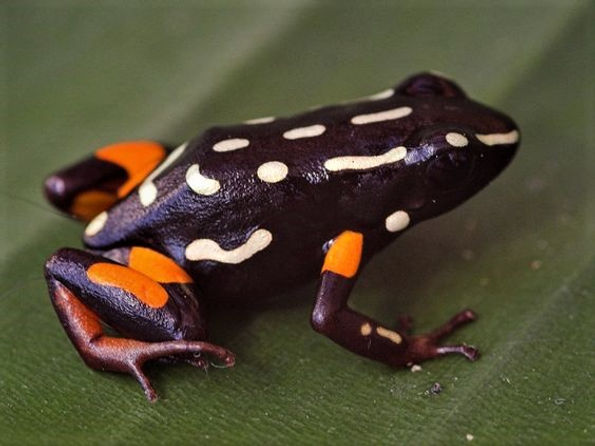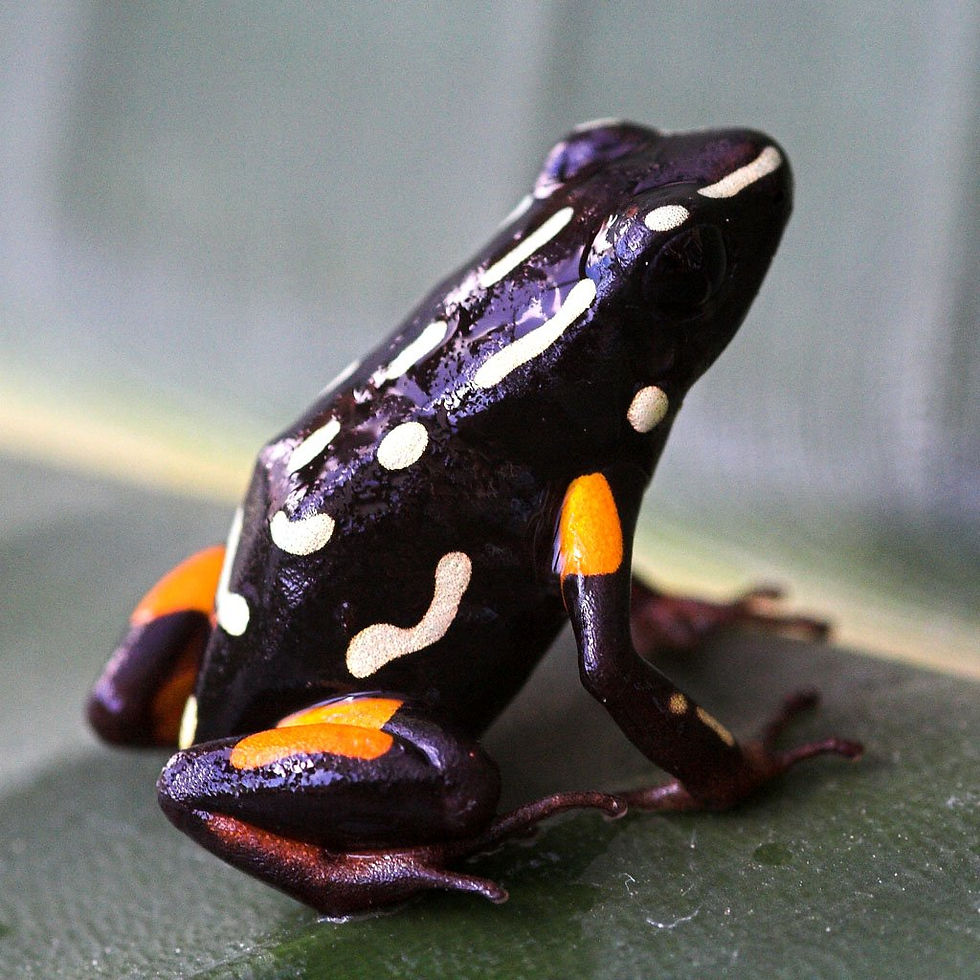2- Adelphobates castaneoticus
The Brazil-nut poison frog
Caldwell & Myers, 1990





From Wikipedia, the free encyclopedia
The Brazil-nut poison frog (Adelphobates castaneoticus) is a species of frog in the family Dendrobatidae. It is endemic to the state of Pará in Brazil.[2] Its natural habitats are tropical moist lowland forests and intermittent freshwater marshes. It is threatened by habitat loss.[1]
The frog is believed to have received its common name from the fact that its tadpoles sometimes develop in the hard capsules of the Brazil nut tree, which are common in its range. The nuts fall to the forest floor where they are broken open by agoutis and other animals seeking the seeds, and empty husks fill with water.[3]
Brazil-nut poison frog



Conservation status :
Least Concern (IUCN 3.1)[1]
Scientific classification :
Kingdom:Animalia
Phylum:Chordata
Class:Amphibia
Order:Anura
Family:Dendrobatidae
Genus:Adelphobates
Species:A. castaneoticus
Binomial name :
Adelphobates castaneoticus
(Caldwell & Myers, 1990)
Synonyms :
Dendrobates castaneoticus Caldwell and Myers, 1990
Description :
The Brazil-nut poison frog is a very small frog with a snout-to-vent length of 18 to 23 mm (0.7 to 0.9 in); females are usually larger than males. The dorsal surface is of a shiny black colour with spots and markings of white or various shades of yellow.[4] There is a bright yellow or orange spot where the foreleg joins the body and two more similarly coloured spots on either side of the knee joint on the hind leg, which combine to make a single large spot when the animal is stationary. A further spot on the underside of the calf is only visible from below.[3]
Distribution :
The Brazil-nut poison frog is endemic to the rainforest of central Brazil. It is known from several localities in the state of Pará; from Cachoeira Juruá, Xingu River, the type locality; from Taperinha some 300 km (186 mi) to the north west;[4] and from Flona Tapajos, Santarém. These locations are some distance apart and it is likely that this frog has a more widespread distribution than is known but has passed undetected in other parts of its range.[1] It lives among the leaf litter on the forest floor and sometimes climbs into low vegetation.[3]
Distribution of the Brazil-nut poison frog
Biology :
The Brazil-nut poison frog is diurnal and feeds on ants, termites and other small invertebrates.[5] The eggs are laid on the ground where they are guarded by the male. When they hatch, it carries the tadpoles to temporary pools such as water holes in trees and stumps, and water-filled empty nut cases on the forest floor.[3] Here the tadpoles develop rapidly, devouring mosquito larvae, smaller tadpoles, and other creatures that share these ephemeral pools, as well as suitably-sized plant material. This frog may become sexually mature in five to seven months.[3]
Status :
The Brazil-nut poison frog is common within its range and the population trend seems stable, although data on its conservation status is somehow insufficient.[4] As a result, the IUCN lists its conservation status as being of "least concern".[5] The main threats it faces are logging, habitat destruction, wildfire and collection of animals to be sold as pets on an international market. There are some conservation areas within its range.[1][3]
For the external links , refrences click here to read the full wikipedia article
Video :
A. castaneoticus in new enclosure
Care Articles :
1-Adelphobates castaneoticus (CALDWELL & MYERS , 1990)
courtesy to : www.dendrobase.de/index.php
Etymology:
The epithetcastaneoticus derives from the Latin word castanea (= chestnut) and the Latin suffix - (t) icus (= belonging). However, it does not refer to the European chestnut but to the Brazil nut or Brazil nut ( Bertholletia excelsa ) which is known in Brazil under the popular name "Castanha do Pará". The naming refers to the fact that the species uses water-filled shells of this plant as a habitat for the larvae.
Synonyms:
Adelphobtes castaneoticus (G RANT , F ROST , C ALDWELL , G AGLIARDO , H ADDAD , K OK , M EANS , N OONAN , S CHARGEL & W HEELER , 2006)
Dendrobates castaneoticus (C ALDWELL & M YERS , 1990)
English name : Brazil nut Poison Frog
german name: Pará Baumsteiger
Classification:
Amphibia-> Anura-> Dendrobatoidea-> Dendrobatidae-> Dendrobatinae-> Adelphobates -> Adelphobates castaneoticus (C ALDWELL & M YERS , 1990)
Note to the scheme:
The species Adelphobates castaneoticus is a type species of the genus Adelphobates and is closely related to A. quinquevittatus (sisters species). The unexpected relational relationship to A. galactonotus first established by V ENCES ET AL . (2003) has been repeatedly confirmed (G RANT ET AL ., 2006).
threat status
Annex II of the WA. Annex B of the EUArtschVO. Notifiable according to BArtSchVO.
In the Red List because of its high adaptability and large-scale distribution as "low-risk" classified (IUCN, 2006).
Despite its minor vulnerability, Brazil has imposed an absolute export ban on this species, as well as many other indigenous species of animals and plants (or products thereof). This serves to avoid biopiracy. The species can therefore not currently be traded legally.
Description :
- size
Small to medium-sized dendrobatide with one KRLfrom 18-23mm.



Grooming:
Skin on the dorsum smooth or finely granulated. Belly usually with smooth skin. Dorsum lacquered black with white dot or line drawing. Legs with bright orange spots on the arms and thighs and on the lower legs. Orange leg drawing too ventral visible. Belly dark gray to black and also with white dot or line drawing. Head narrower than the body. Snout rounded to truncated. No teeth available. Nostrils close to the edge of the nose. Not visible in the supervision. Eye diameter corresponds approximately to the snout length (about 7.5 mm). tympanum variably concealed and much smaller than eye diameter. First finger shorter than finger two.finger formula : 1 <2 <4 <3. Finger disks on all fingers except finger 1 clearly widened. At fingers three about 2 times as wide as the finger. Single Round to Elliptical Inner Metacarpal tubercle , Outer metacarpal tubercle is missing. One or two roundish subarticular tubercles (two on fingers 3, one on each finger 1, 2 and 4). toes formula : 1 <2 <5 <3 <4. Toe 1 without widened toe, widening others, but not as strong as on the fingers. Elliptic outer metacarpal tubercle and round inner metacarpal tubercle. One to three roundish subarticular tubercles (one at toe 1 and 2, two at fingers 3 and 5 and three at toe 4). A clearer Sexual dimorphismis missing. However females are about 2.5 mm larger than the males. Males show one subgulare Sonic balloon and usually two voice slots, one of which is often formed back.

Dorsal and ventral view Adelphobates castaneoticus
Variation:
Two variants are known so far. They differ in body size, the coloring of the leg drawing and the dorsal drawing. The spots of the larger variant are colored golden orange and the animals show a rather line-like white drawing on the dorsum. The smaller variant has rather yellow spots and a rather punctiform drawing on the dorsum (D USCHA , 2006).
Older:
Not known.
Maturity:
Probably as with other small species with 12-15 months.
Type find location of the first description
03 ° 22'S, 51 ° 51'W. Cachoiera Juruá, Río Xingu, State of Pará, Brazil
Distribution:
State of Pará, Brazil
Photos :







2- Adelphobates castaneoticus “Brazil Nut frog”
courtesy to : saurian.net/frog_d_castaneoticus.html
For more information about resources for the above article .. click here
The Brazil nut frog is a lowland forest frog, which is named for the nut pods that litter the forest floor in its native habitat. Black with a myriad of small spots of orange or yellow and white, it's truly a beauty! This frog, as well as A. quinquevittatus, which comes from the same area in Brazil, is somewhat isolated from the other thumbnail frogs, with its range being about 800 miles from the Peruvian thumbnail frogs habitats. The habitat is remote enough that the frog was not classified by science until 1990.


The nut pods for which the frog is named are often used as tadpole deposition sites by the frogs. This frog is a more terrestrial frog, and while it will explore the entire tank, seems to spend more time on the floor of the tank than any of the other thumbnail frogs I have worked with.
This frog is considered by some to be illegal in the United States, in fact anywhere out side of Brazil. The government of Brazil has had a policy of not allowing the export of their wild life, and in general dart frogs have not been exported from Brazil. The story on the Brazil nut frogs is that in the early nineties, a few specimens were allowed to be exported from Brazil for use by a US institution, which shall remain nameless. These frogs apparently were released to the institution on the condition that they remain the property of the Brazilian government, and that any and all offspring would also remain the property of the Brazilian government. In addition the frogs were not to be released to any other institutions or the public. Obviously this condition was not followed, and the frogs were released to another institution, which then released offspring to the US frog hobby. I am unsure how seriously to take this, there are numerous frogs in the US hobby whose ancestors came from illegal sources, or were never legally exported from the country of origin. This list would include any frog that originates in Brazil, such as A. quinquevittatus, and A. galactonotus. To the best of my knowledge neither frog has been legally exported from Brazil, but both found there way to Europe, and then captive bred offspring were sent to the US with “legal” paperwork, generated by European governments which were not very particular about the frogs paper trail, and documentation of the breeders frogs.
Synonyms : none
Locality : western Brazil
Temps : upper seventies to low eighties
Humidity : High
Terrarium Preferences :
No special requirements, ten gallons, ten gallon talls, fifteen gallon or twenty tall tanks all make good choices, but well planted tanks are one of the keys to seeing more of these frogs. More floor space will also promote visibility.
Size :
about 3/4 th inch
Visibility in the tank :
Moderately shy
Groups of these compatible :
Groups seem to do well together.
Experience Level :
Intermediate
Compatible with other species?
Most often kept by themselves, but experienced keepers might try keeping them in tanks with larger species. Allow plenty of room.
Breeding :
Often a difficult species to breed. We have set up several different groups with no results, but once a group or pair begins breeding, they are often pretty easy. However many other breeders have had problems raising tadpoles successfully.
Status in Hobby :
a not uncommon frog, but not as popular as some of the flashier thumbnails. Limited bloodlines, with only one founder group. By now European breeders are reported have imported (smuggled) frogs from Brazil and there appear to be new bloodlines in Europe, however due to the “hot button” status of this species, in so far as the US Fish and Wildlife Agency is concerned, its not likely that any will be coming in to the US legally any time soon.
Update, 2010- This frog is still of uncertain legal status. In addition, due to the questionable legality of these frogs, many breeders, ourselves included, no longer work with these frogs.
Future availability of these frogs is likely to be very limited.
Other websites :
- www.gifkikkerportaal.nl/Artikelen/adelphobates-castaneoticus
- amphibiaweb.org/species/1629
- www.iucnredlist.org/details/55179/0
- animaldiversity.org/accounts/Adelphobates_castaneoticus/classification/
Madagascar Dart frogs
Aromobatidae :
-
Allobatinae
-
Anomaloglossinae
-
Aromobatinae
South America Dart Frogs - Species
Dendrobatidae :
-
Colostethinae
-
Dendrobatinae
-
Hyloxalinae